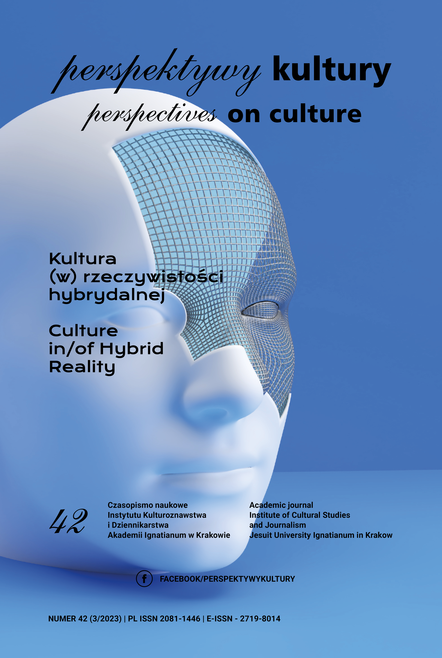Cyborg: The Marriage of Humanity and Technology
Abstract
This text is the first essay on human cyborgization in the context of contemporary theories and original research on this phenomenon. Depending on one’s chosen definition, which have evolved over the years, a cyborg can be called a person whose body has been permanently joined with a machine or any technological creation or a person who uses the achievements of technology but whose body is not permanently connected with a machine, computer, or any other artificial technological product. Thus, the first category includes, for example, people living with a pacemaker implant or those with artificial limbs. The second category includes people whose daily activity is supported by technology, but artificial technological elements have not been permanently fixed to their bodies. In today’s technological culture, in the information society, practically all of us meet these criteria. According to the extended theory, each of us is a cyborg. This article presents the genesis of the term cyborg and issues related to cyborgs of the first type functioning in the modern world. Cases of people-machines are presented and ethical and legal problems connected with such people functioning in society are discussed.
References
Arendt, H. (1958). The Human Condition. Chicago: The University of Chi-cago Press.
Camporesi, S. (2008). Oscar Pistorius, Enhancement and Post-humans. Journal of Medical Ethics, nr 34(9), 639.
Chorost, M. (2005). Rebuild. How Becoming Part Computer Made Me More Human. Nowy York: Houghton Mifflin.
Clynes, M.E. i Kline, N.S. (1960). Cyborgs and Space. Astronautics, nr 9, 27–31.
Downey, G.L. i Dumit, J. (1997). Locating and Intervening. An Introduc-tion. W: G.L. Downey i J. Dumit (red.), Cyborgs & Citadels. Anthropo-logical Interventions in Emerging Sciences and Technologies. Santa Fe: School of American Research Press, 5–29.
Greguric, I. (2022). Philosophical Issues of Human Cyborgization and the Necessity of Prolegomena on Cyborg Ethics. Zagreb: IGI Global.
Guglielmelli, E. (2014). Bionic hand is best hope to restore sense of touch. IEEE Robotics & Automation Magazine, 88–89.
Hughes, J. (2004). Citizen Cyborg. Why Democratic Societies Must Re-spond to the Redesigned Human of the Future. Cambridge: Westview Press.
Ilnicki, R. (2011). Bóg cyborgów. Technika i transcendencja. Poznań: Wy-dawnictwo Naukowe Wydziału Nauk Społecznych UAM.
Khanna, A. i Khanna, P. (2011). Technology Will Take on a Life of Its Own Welcome to the Hybrid Age. Foreign Policy, nr 188, 67–70, 72–73.
Kline, R. (2009). Where are the Cyborgs in Cybernetics? Social Studies of Science, nr 39(3), 331–362.
Kline, R. (2015). The Cybernetics Moment. Or Why We Call Our Age the Information Age. Baltimore: Johns Hopkins University Press.
Longman, J. (2007). An amputee sprinter: is he disabled or too-abled? The New York Times, 15.05.2007.
Pearlman, E. (2015). I, Cyborg. A Journal of Performance and Art, nr 37(2), 84–90.
Warwick, K. (2021). Experiments with Cyborg Technology. W: Ch.H. Gray, H.J. Figueroa-Sarriera, i S. Mentor (red.), Modified. Living as a Cyborg. New York: Routledge, 50–57.
Wiener, N. (1948). Cybernetics. Scientific American, nr 179, 14–19.
Copyright (c) 2023 Jesuit University Ignatianum in Krakow

This work is licensed under a Creative Commons Attribution 4.0 International License.
Autor, zgłaszając swój artykuł, wyraża zgodę na korzystanie przez Wydawnictwo Uniwersystet Ignatianum z utworu na następujących polach eksploatacji:
- utrwalania utworu w formie papierowej, a także na nośniku cyfrowym lub magnetycznym;
- zwielokrotnienia utworu dowolną techniką, bez ograniczenia ilości wydań i liczby egzemplarzy;
- rozpowszechniania utworu i jego zwielokrotnionych egzemplarzy na jakimkolwiek nośniku, w tym wprowadzenia do obrotu, sprzedaży, użyczenia, najmu;
- wprowadzenia utworu do pamięci komputera;
- rozpowszechniania utworu w sieciach informatycznych, w tym w sieci Internet;
- publicznego wykonania, wystawienia, wyświetlenia, odtworzenia oraz nadawania i reemitowania, a także publicznego udostępniania utworu w taki sposób, aby każdy mógł mieć do niego dostęp w miejscu i czasie przez siebie wybranym.
Wydawca zobowiązuje się szanować osobiste prawa autorskie do utworu.





